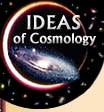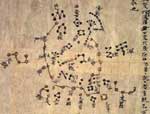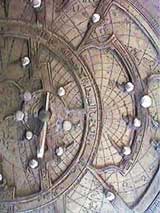
|
|
 |
The
Greek Worldview |

|
|
 Astrology:
Star mappers—the
first Cosmologists
Astrology:
Star mappers—the
first Cosmologists |
Underlying the Greek worldview was the philosophy of Plato. He sought a deeper level of reality than that accessible to the senses. He also pursued a simple theory about the universe which had incredible explanatory power. The result was a belief in uniform, circular motion. This belief dominated the thinking of many Western astronomers and cosmologists for two thousand years. The task for astronomers was to ascertain the motions of the planets. Sky-watchers in the ancient Middle East, Central America, and China made many observations. From their tables of numbers, they devised schemes to predict future movements in the heavens. But the explanations that the Babylonians, Mayans, and early Chinese sky-watchers devised for these movements were no more than colorful myths. Scientific cosmology — the search for a picture of the universe that would make sense with no mention of divine beings — began with the Greeks. They sought to look beyond the patterns of numbers to something fundamental. Under Plato's influence, Greek thinkers attempted to devise combinations of uniform circular motions that would reproduce the observed motions, which were far from regular. |
|
|||
| Greek philosopher-scientists set themselves the task of envisioning the universe as a set of physical objects. Plato's pupil Aristotle came to dominate thinking in this field. Where Platonists thought in terms of the idealized mathematics of two-dimensional circles, the Aristotelians envisioned actual three-dimensional spheres. Aristotle taught that rotating spheres carried the Moon, Sun, planets, and stars around a stationary Earth. The Earth was unique because of its central position and its material composition. All generation and corruption occurred in the "sublunar" region, below the Moon and above the Earth. This region was composed of the four elements: earth, water, air, and fire. Beyond the Moon was the unchanging and perfect celestial region. It was composed of a mysterious fifth element. Greek philosophers estimated the distance to the Moon, and even tried to calculate the size of the entire universe. They believed it was finite. The outer sphere of the stars carried them on their nightly course around the Earth. The natural place for earthy material was down at the center of the universe. Earthy material tended to move to its natural place, toward the center of the world. Flames moved upward to reach their natural place at the top of the sublunar region. There could be no other worlds scattered throughout this universe, because their earthy nature would have forced them to move toward their natural place at the center. With the Earth at its center and the sphere of the stars its outer boundary, the Aristotelian cosmos consisted of little more than our solar system. Continuation of the Greek tradition of Plato and Aristotle is exemplified in the work of Claudius Ptolemy. He systematized hundreds of years of Greek geometrical cosmology with rigorous demonstrations and proofs. |
||
|
Ptolemy wrote his mathematical treatise, later named the Almagest, in about 150 A.D. He worked out geometrical systems of compound motions on two-dimensional circles to match the observed motions. The heavens were not made of rocks, metal, or other earthy material, but of some divine celestial material. This offered no obstruction to the passage of one part through another. |
|
|
|
|
|
|
The spheres rotated because that was their natural motion. It was proper, Ptolemy believed, to attribute uniform circular motion to the planets because disorder and nonuniformity were alien to divine things. The study of astronomy, dealing with divine things, was especially useful for elevating the human soul.
|
|||
|
 Detail of an astrolabe. The curved points map the positions of bright stars. MORE on astrolabes and observatories |
Islamic civilization enjoyed a high level of scientific work. Astronomy was important for giving times of prayer (from the altitude of the Sun or stars), and the qibla, or sacred orientation: worshippers anywhere in the world needed to know the direction of Mecca so they could face it while praying, and mosques were oriented toward the holy city. The astrolabe was the fundamental astronomical instrument, serving as a clock and navigational tool. Islamic princes also constructed giant instruments to measure the positions of planets and stars for astrological purposes. Among the Arabs and Persians were great calculators and mathematicians who worked to improve the cosmological explanation of astronomical measurements. For example, Nasir al-din al-Tusi at Maragha produced a particularly innovative addition to Ptolemy's circular motions. The "Tusi couple" calculates a linear motion from a combination of uniform circular motions. In his revolutionary work on the solar system published in 1543, Copernicus used a strikingly similar device. Also, Copernicus used a model for the Moon's motion identical to one devised two centuries earlier by the astronomer Ibn al-Shatir in Damascus. Copernicus cited the works of Islamic astronomers and certainly learned from them. Historians are still trying to determine the full extent of his intellectual debt. |
|
Copyright ©. Brought to you by the Center for History of Physics, a Division of the American Institute of Physics |
|
|
*Click on images and links above for more information. |